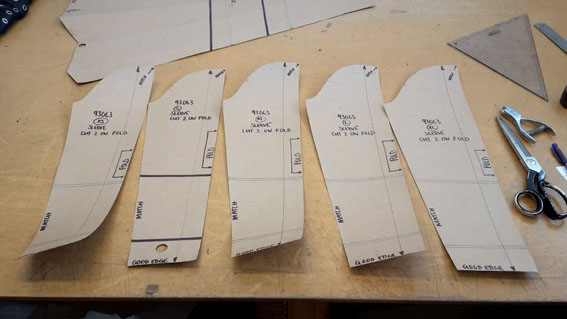Some of you expressed an interest in hearing more about my ‘day job’. This is something I have largely avoided on my blog because a lot of it is confidential, as you can probably understand! There are snippets I can show you though, so here is the first in a series of occasional ‘Industry Insight’ posts.
Although it is Spring 2016 showing in New York and London, here in New Zealand the opposite is happening. Our Winter 2016 collection is showing, and even though the agents are still out there selling, production has already begun. For me this means it is grading season!
All the selling samples in our collection are made in size 10/Small. As a patternmaker it is really convenient for fitting purposes that I am almost a perfect size 10 too! Obviously the rest of the world is not a size 10 as well, so patterns for all the other sizes need to be created before garment production can proceed.
At my workplace we do this by manually grading sizes up and down from the size 10 (S) pattern.
 |
| Grading the XS sleeve from the S Sleeve |
Yes it is all done by hand – and there is a lot of cutting to do! Larger organisations might use a CAD system but we still do it the traditional way.
 |
| All the sleeves graded and cut out |
We usually grade five sizes in total – XS/S/M/L/XL (3 up, 1 down) and sometimes we grade an XXS or XXL if they are requested by buyers.
After cutting them all out, each piece is nested to check for accuracy:
 |
| The Backs nested |
 |
| Nice accurate work! |
This simple top took only an hour to grade, but the lined coat-with-a-zillion-pieces I graded earlier in the week took me the whole day!
Grading can get a bit monotonous, but it is also therapeutic after the stress and deadlines of producing a sample range. Most of the styles will be graded in the next month or two, and then the fashion cycle begins all over again as we start to design our Spring 2016!


Is there a website of the company you work for, so that we can see the garments they sell?
LikeLike
Thanks for posting this. It is interesting. Sounds like there is no 'quiet time' of year in the garment industry!
LikeLike
Thanks for sharing! I worked in production as a technical designer is this brought me back to those days. Even within the industry, there a many trade secrets.
LikeLike
So wonderful!
LikeLike
Bahaha! That does sound convenient being the “perfect” size. 😉
I'm fascinated that you do the grading manually… I guess I had assumed everything in the industry would be computerized by now. (Not sure why I'd assume that—I don't exactly work in cutting edge industries myself. 😉 ) thank you for sharing this sneak-peak! 🙂
LikeLike
Super interesting! I'd love to see more of the behind-the-scenes at your work, if you can share it with us.
LikeLike
Very interesting, I love to hear what goes on behind the scenes! Thanks for sharing!
LikeLike
I don't work for a clothing company but I can manually grade and was taught by an ex tutor from AUT who also manually grades. I would love to know who you work for (out of pure NZ Interest). I work at an academy teaching pattern making so it is great to have some insight into the business side of the job I do
LikeLike
I was surprised to see a sleeve pattern with a fold line. How will that work on the marker?
LikeLike
I'm kind of reluctant to disclose the company I work for, to retain the privacy of where I live Karien – I hope you can understand!
LikeLike
Ha – yes it would be perfect if I didn't have to strip down twice a day and try on skimpy summer samples in freezing cold winter, and woollen samples during a humid summer! The things you do 🙂
LikeLike
No marker necessary Lisa! This pattern is for knit garment cut from a circular knitted panel – one body piece and half a sleeve (ie, on fold).
LikeLike
Who was the AUT tutor Jo? They may have taught me! We have a few students from AUT and other universities doing work experience every now and then.
LikeLike
Lovely to see the manual approach still being used comercially- we use CAD and I always feel something is lost with digitization (though appreciate its speed). When ever I'm back in Auckland for a bit I refresh my skills with Don & Anne so as not to lose them!
LikeLike
Don Hellier- though he taught me as part of my job at the NZ Academy of Fashion (big title, small organisation)
LikeLike
Wow, amazing that you do your grading manually. I took a class in CAD grading and we never really discussed the benefits over doing it by hand vs CAD. What a great day job – thanks for sharing!
LikeLike